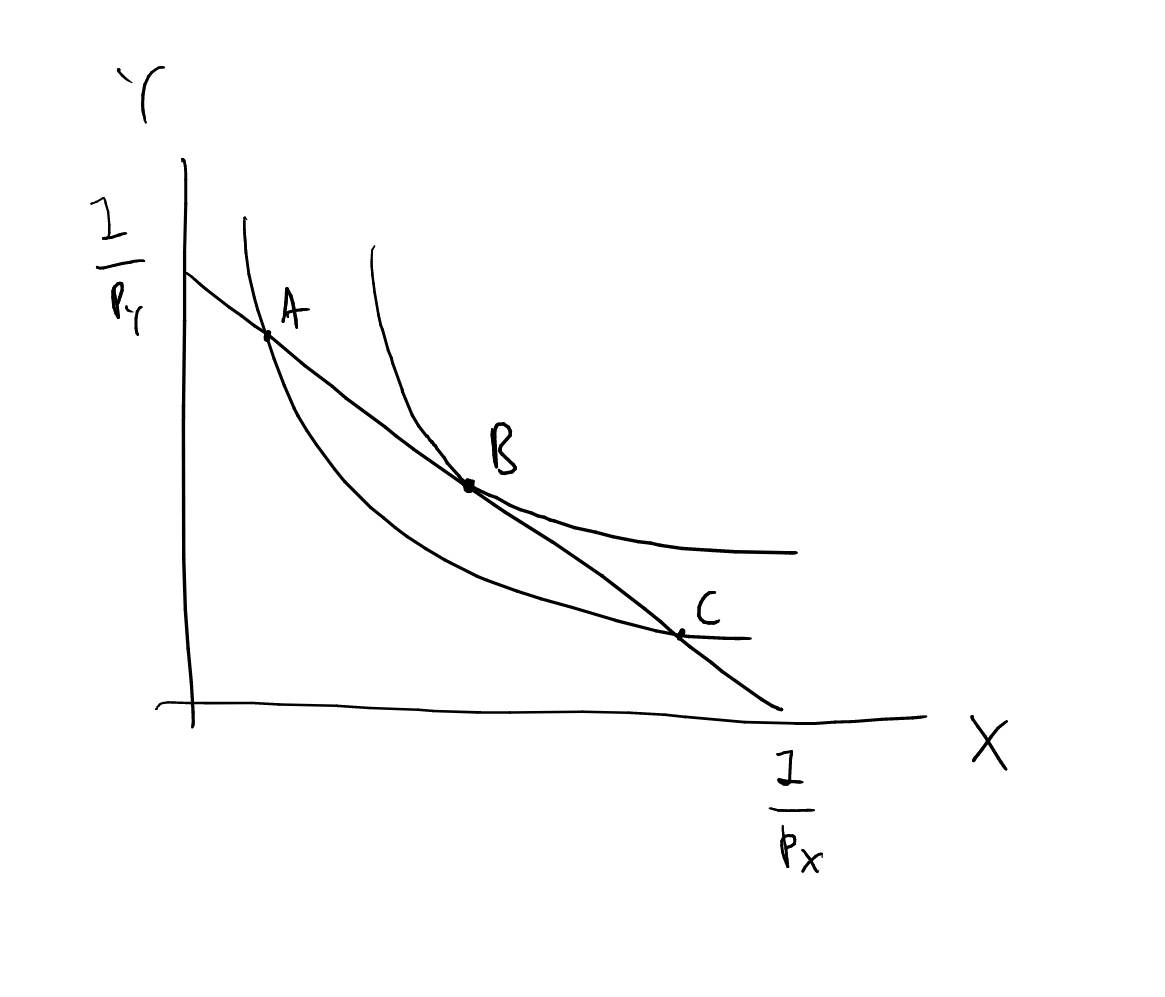Utility
Utility is an ordinal concept that allows a consumer to rank choices.
Consumers behave to maximize their utility. They have preferences, which is what they want, and they get as much as possible within a certain budget.
Preference assumptions
We make three assumptions about the preferences of consumers:
- Completeness: Consumers do have an opinion on all possible choices.
- Transitivity: $ A > B, B > C \implies A > C $
- Non-satiation: More is always better.
- Marginal utility is always positive.
Indifference curves
A plot of indifference curves is a graphical map of preferences. The two axes on such a plot are two different goods, and a consumer is indifferent between any of the combinations of goods on an indifference curve.
Properties of indifference curves
- Consumers prefer higher indifference curves.
- Indifference curves must slope downwards due to non-satiation.
- Indifference curves may not cross due to transitivity.
- There is only one indifference curve through every possible combination of goods.
Utility functions
A utility function is a mathematical representation of the preferences of a consumer.
Consider the following utility function for an individual consuming good X and good Y:
$$ U = \sqrt{XY} $$
Marginal utility is the derivative of utility with respect to the quantity of a good. Marginal utility generally diminishes as the number of goods consumed increases. The marginal utility for good X in the example is:
$$ \frac{\partial U}{\partial X} = \frac{1}{2}\sqrt{\frac{Y}{X}} $$
We can see that this quantity decreases for increasing values of $X$.
Marginal rate of substitution
The marginal rate of substitution (MRS) is the slope of the indifference curve. It denotes the quantity of one good that you are willing to give up to get one more of another good.
$$ MRS = \frac{\Delta Y}{\Delta X} = -\frac{MU_X}{MU_Y}$$
Here, MRS is defined as the amount of good Y you would give up for an extra unit of good X. MRS is always negative since the indifference curve is always downward sloping. MRS also tells us the relative marginal utilities of the two goods along the indifference curve. Intuitively, if you have a lot of good X, you will want the next unit of good X less, decreasing $MU_X$ and therefore decreasing how much of good Y you would give up for an extra unit of good X.
Diminishing marginal utility implies that indifference curves are non-concave relative to the origin.
Budget constraints
Assume that the amount a consumer can spend is equal to their income.
$$ \mathrm{Budget} = \mathrm{Income} $$
If a consumer can spend their income on either good X or good Y, the budget constraint equation is given by:
$$ I = X p_X + Y p_Y $$
This can be represented as a line on a graph:
The slope of this line is the marginal rate of transformation (MRT):
$$ \mathrm{MRT} = - \frac{p_X}{p_Y} $$
Because of the budget constraint, buying more of one good results in buying less of the other, which is effectively “transforming” one good into the other.
The opportunity set is the set of available choices given a budget constraint and prices of goods. Graphically, it's represented as the area under the budget constraint curve.
A change in prices will cause the slope and intercepts to change. A change in the budget will cause the intercepts to change, but not the slope.
Constrained choices
Consumers will achieve the most utility given the constraint of their budget. Graphically, this means that they will achieve the highest indifference curve (each of which has represents one value of utility) that intersects with the budget constraint curve. Therefore, the optimal point is the point of the indifference curve that is tangent to the budget constraint curve.
In this plot, point B is the optimal point.
The following equation comes from the fact that the indifference curve and budget constraint curve have the same slope at the optimal point:
$$ \mathrm{MRT} = -\frac{\mathrm{MU}_X}{\mathrm{MU}_Y} = -\frac{P_X}{P_Y} = \mathrm{MRT} $$
Rearranging the equation:
$$ \frac{\mathrm{MU}_X}{P_X} = \frac{\mathrm{MU}_Y}{P_Y} $$
As a reminder, MRT is the amount of one good you are willing to give up in exchange for another, and MRS is the amount of one good that the market is asking you to give up in exchange for another (because of budget constraints). A consumer will effectively trade one good for another until these two quantities are equal.
Paternalism
Paternalism is the government imposing its preferences on consumers.


